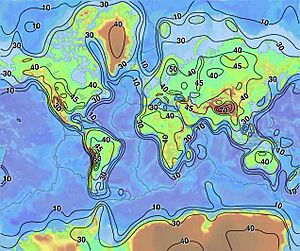Continental crust facts for kids
The continental crust is the part of Earth's outer layer that forms the continents. It also includes the shallow areas of the seabed near the continents, called continental shelves.
This crust is mostly made of rocks like granitic, sedimentary, and metamorphic rocks. These rocks contain minerals such as feldspar.
The continental crust is less dense (lighter for its size) than the material found deeper inside the Earth, in the mantle. The mantle is made of heavier, mafic rocks. The continental crust is also less dense than the oceanic crust, which is the crust under the oceans.
Even though it's lighter, the continental crust is much thicker than the oceanic crust. It's usually about 35 to 40 kilometers (about 22 to 25 miles) thick. The oceanic crust, however, is only around 7 to 10 kilometers (about 4 to 6 miles) thick. About 40% of the Earth's surface is covered by continental crust.
The continental crust meets the oceanic crust at a place called the continental margin. This is where the land mass ends and the deep ocean floor begins.
Contents
What is the Continental Crust Made Of?
The continental crust is like a giant puzzle made of different types of rocks.
Igneous Rocks
Many parts are made of igneous rocks, like granite. These rocks form when hot, melted rock (magma) cools down and hardens. Granite is a common rock found in mountains and under continents.
Sedimentary Rocks
You'll also find sedimentary rocks. These rocks form from tiny bits of other rocks, sand, or shells that get pressed together over a long time. Think of layers of mud turning into solid rock.
Metamorphic Rocks
Finally, there are metamorphic rocks. These are rocks that have changed due to extreme heat and pressure deep inside the Earth. They started as igneous or sedimentary rocks but transformed into something new.
How Thick is the Continental Crust?
The continental crust is much thicker than the oceanic crust. Imagine a thick blanket covering the land.
Comparing Thickness
On average, the continental crust is about 35 to 40 kilometers (22 to 25 miles) thick. In some mountain ranges, it can be even thicker, reaching up to 70 kilometers (43 miles)!
Oceanic Crust Comparison
In contrast, the oceanic crust is quite thin, usually only 7 to 10 kilometers (4 to 6 miles) thick. This difference in thickness is one reason why continents stand high above the ocean floor.
How Does the Continental Crust Move?
The Earth's outer layer is broken into huge pieces called tectonic plates. The continental crust rides on top of these plates.
Plate Movement
These plates are always moving, very slowly, like giant rafts on a liquid layer below. This movement causes continents to drift, mountains to form, and earthquakes to happen.
Continental Margins
The edge of a continent, where it meets the ocean, is called the continental margin. This is often where the continental crust transitions into the thinner oceanic crust.
See also
 In Spanish: Corteza continental para niños
In Spanish: Corteza continental para niños
Images for kids



